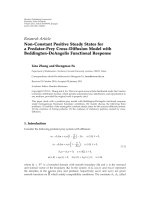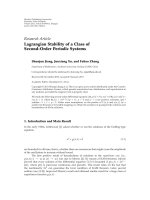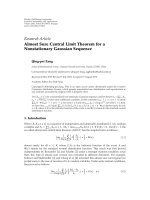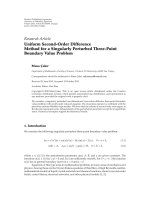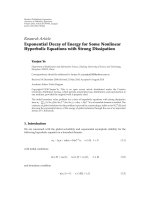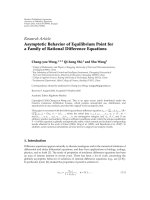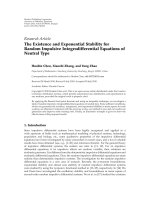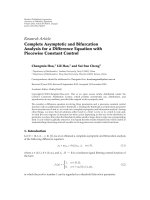báo cáo hóa học:" Research Article Exponential Stability and Global Attractors for a Thermoelastic Bresse System" pdf
Bạn đang xem bản rút gọn của tài liệu. Xem và tải ngay bản đầy đủ của tài liệu tại đây (518.83 KB, 15 trang )
Hindawi Publishing Corporation
Advances in Difference Equations
Volume 2010, Article ID 748789, 15 pages
doi:10.1155/2010/748789
Research Article
Exponential Stability and Global Attractors for
a Thermoelastic Bresse System
Zhiyong Ma
College of Science, Shanghai Second Polytechnic University, Shanghai 201209, China
Correspondence should be addressed to Zhiyong Ma,
Received 13 September 2010; Accepted 29 October 2010
Academic Editor: E. Thandapani
Copyright q 2010 Zhiyong Ma. This is an open access article distributed under the Creative
Commons Attribution License, which permits unrestricted use, distribution, and reproduction in
any medium, provided the original work is properly cited.
We consider the stability properties for thermoelastic Bresse system which describes the motion
of a linear planar shearable thermoelastic beam. The system consists of three wave equations and
two heat equations coupled in certain pattern. The two wave equations about the longitudinal
displacement and shear angle displacement are effectively damped by the dissipation from the
two heat equations. We use multiplier techniques to prove the exponential stability result when
the wave speed of the vertical displacement coincides with the wave speed of the longitudinal or
of the shear angle displacement. Moreover, the existence of the global attractor is firstly achieved.
1. Introduction
In this paper, we will consider the following system:
ρhw
1tt
Eh
w
1x
− kw
3
− αθ
1t
x
− kGh
φ
2
w
3x
kw
1
, 1.1
ρhw
3tt
Gh
φ
2
w
3x
kw
1
x
kEh
w
1x
− kw
3
− kαθ
1t
, 1.2
ρIφ
2tt
EIφ
2xx
− Gh
φ
2
w
3x
kw
1
− αθ
3x
, 1.3
ρcθ
1tt
θ
1xxt
θ
1xx
− αT
0
w
1tx
− kw
3t
, 1.4
ρcθ
3t
θ
3xx
− αT
0
φ
2tx
, 1.5
together with initial conditions
w
1
x, 0
u
0
x
,w
1t
x, 0
v
0
x
,φ
2
x, 0
φ
0
x
,
φ
2t
x, 0
ψ
0
x
,w
3
x, 0
w
0
x
,w
3t
x, 0
ϕ
0
x
,
θ
1
x, 0
θ
0
x
,θ
1t
x, 0
η
0
x
,θ
3
x, 0
ξ
0
x
1.6
2 Advances in Difference Equations
and boundary conditions
w
1
x, t
w
3x
x, t
φ
2
x, t
θ
1
x, t
θ
3
x, t
0, for x 0, 1, 1.7
where w
1
, w
3
,andφ
2
are the longitudinal, vertical, and shear angle displacement, θ
1
and θ
3
are the temperature deviations from the T
0
along the longitudinal and vertical directions, E,
G, ρ, I, m, k, h,andc are positive constants for the elastic and thermal material properties.
From this seemingly complicated system, very interesting special cases can be
obtained. In particular, the isothermal system is exactly the system obtained by Bresse 1 in
1856. The Bresse system, 1.1–1.3 with θ
1
, θ
3
removed, is more general than the well-known
Timoshenko system where the longitudinal displacement w
1
is not considered. If both θ
1
and
w
1
are neglected, the Bresse thermoelastic system simplifies to the following Timoshenko
thermoelastic system:
ρhw
3tt
Gh
φ
2
w
3x
x
,
ρIφ
2tt
EIφ
2xx
− Gh
φ
2
w
3x
− αθ
3tx
,
ρcθ
3tt
θ
3xxt
θ
3xx
− αT
0
φ
2tx
,
1.8
which was studied by Messaoudi and Said-Houari 2. For the boundary conditions
w
3
x, t
φ
2
x, t
θ
3x
x, t
0, at x 0,l, 1.9
they obtained exponential stability for the thermoelastic Timoshenko system 1.8 when
E G; later, they proved energy decay for a Timoshenko-type system with history in
thermoelasticity of type III 3, and this paper is similar to 2 with an extra damping that
comes from the presence of a history term; it improves the result of 2 in the sense that the
case of nonequal wave speed has been considered and the relaxation function g is allowed to
decay exponentially or polynomially. We refer the reader to 4–10 for the Timoshenko system
with other kinds of damping mechanisms such as viscous damping, viscoelastic damping of
Boltzmann type acting on the motion equation of w
3
or φ
2
. In all these cases, the rotational
displacement φ
2
of the Timoshenko system is effectively damped due to the thermal energy
dissipation. In fact, the energy associated with this component of motion decays exponen-
tially. The transverse displacement w
3
is only indirectly damped through the coupling, which
can be observed from 1.2.Theeffectiveness of this damping depends on t he type of coupling
and the wave speeds. When the wave speeds are the same E G, the indirect damping is
actually strong enough to induce exponential stability for the Timoshenko system, but when
the wave speeds are different, the Timoshenko system loses the exponential stability. This
phenomenon has been observed for partially damped second-order evolution equations. We
would like to mention other works in 11–15 for other related models.
Recently, Liu and Rao 16 considered a similar system; they used semigroup method
and showed that the exponentially decay rate is preserved when the wave speed of the
vertical displacement coincides with the wave speed of longitudinal displacement or of the
shear angle displacement. Otherwise, only a polynomial-type decay rate can be obtained;
their main tools are the frequency-domain characterization of exponential decay obtained by
Pr
¨
uss 17 and Huang 18 and of polynomial decay obtained recently by Mu
˜
noz Rivera and
Fern
´
andez Sare 5. For the attractors, we refer to 19–24.
Advances in Difference Equations 3
In this paper, we consider system 1.1–1.5; that is, we use multiplier techniques to
prove the exponential stability result only for E G. However, from the theory of elasticity,
E and G denote Young’s modulus and the shear modulus, respectively. These two elastic
moduli are not equal since
G
E
2
1 ν
,
1.10
where ν ∈ 0, 1/2 is the Poisson’s ratio. Thus, the exponential stability for the case of E G is
only mathematically sound. However, it does provide useful insight into the study of similar
models arising from other applications.
2. Equal Wave Speeds Case: E G
Here we state and prove a decay result in the case of equal wave speeds propagation.
Define the state spaces
H H
1
0
× H
1
∗
× H
1
0
× H
1
0
×
L
2
5
,
2.1
where
H
1
∗
f ∈ H
1
0, 1
|
1
0
f
x
0
. 2.2
The associated energy term is given by
E
t
1
2
1
0
Eh
w
1x
− kw
3
2
Gh
φ
2
w
3x
kw
1
2
EIφ
2
2x
ρh
w
2
1t
w
2
3t
ρIφ
2
2t
ρc
T
0
θ
2
1t
θ
2
1x
θ
2
3
dx.
2.3
By a straightforward calculation, we have
dE
t
dt
−
1
T
0
θ
1xt
2
θ
3x
2
. 2.4
From semigroup theory 25, 26, we have the following existence and regularity result;
for the explicit proofs, we refer the reader to 16.
4 Advances in Difference Equations
Lemma 2.1. Let u
0
x,w
0
x,ϕ
0
x,θ
0
x,v
0
x,φ
0
x,ψ
0
x,η
0
x,ξ
0
x ∈Hbe given. Then
problem 1.1–1.5 has a unique global weak solution ϕ, ψ, θ verifying
w
3
x, t
∈ C
R
,H
1
∗
0, 1
∩ C
1
R
,L
2
0, 1
,
w
1
x, t
,φ
2
x, t
,θ
1
x, t
,θ
3
x, t
∈ C
R
,H
1
0
0, 1
∩ C
1
R
,L
2
0, 1
.
2.5
We are now ready to state our main stability result.
Theorem 2.2. Suppose that E G and u
0
x,w
0
x,ϕ
0
x,θ
0
x,v
0
x,φ
0
x,ψ
0
x,η
0
x,
ξ
0
x ∈H. Then the energy Et decays exponentially as time tends to infinity; that is, there exist two
positive constants C and μ independent of the initial data and t, such that
E
t
≤ CE
0
e
−μt
, ∀t>0. 2.6
The proof of our result will be established through several lemmas.
Let
I
1
1
0
ρIφ
2t
φ
2
ρhw
3t
f,
2.7
where f is the solution of
−f
xx
φ
2x
,f
0
f
1
0. 2.8
Lemma 2.3. Letting w
1
, w
3
, φ
2
, θ
1
, θ
3
be a solution of 1.1–1.5, then one has, for all ε
1
> 0,
I
1
t
dt
≤−
EI
2
φ
2x
2
ρIφ
2t
2
ε
1
w
3t
2
w
1x
− kw
3
2
C
ε
1
θ
3x
2
θ
1xt
2
φ
2t
2
.
2.9
Proof.
dI
1
dt
−EIφ
2x
2
ρIφ
2t
2
−
1
0
αθ
3x
φ
2
dx
− kEh
1
0
w
1x
− kw
3
fdx − kα
1
0
θ
1t
fdx ρh
1
0
w
3t
f
t
dx,
2.10
By using the inequalities
1
0
f
2
x
dx ≤
1
0
φ
2
2
dx ≤
1
0
φ
2
2x
dx,
1
0
f
2
t
dx ≤
1
0
f
2
tx
dx ≤
1
0
φ
2
2t
dx,
2.11
and Young’s inequality, the assertion of the lemma follows.
Advances in Difference Equations 5
Let
I
2
ρcρh
1
0
x
0
θ
1t
dy
w
1t
dx.
2.12
Lemma 2.4. Letting w
1
, w
3
, φ
2
, θ
1
, θ
3
be a solution of 1.1–1.5, then one has, for all ε
2
> 0,
dI
2
t
dt
≤
−αρhT
0
2
1
0
w
2
1t
dx C
ε
2
θ
1xt
2
w
3t
2
ε
2
w
1x
− kw
3
2
φ
2
w
3x
kw
1
2
.
2.13
Proof. Using 1.4 and 1.1,weget
I
2
t
dt
ρcρh
1
0
x
0
θ
1tt
dy
w
1t
dx ρcρh
1
0
x
0
θ
1t
dy
w
1tt
dx
ρh
1
0
x
0
θ
1xxt
θ
1xx
− αT
0
w
1tx
− kw
3t
dy
w
1t
dx
1
0
x
0
θ
1t
dy
Eh
w
1x
− kw
3
− αθ
1t
x
− KGh
φ
2
w
3x
kw
1
dx
ρh
1
0
θ
1xt
θ
1x
w
1t
dx − ρhαT
0
1
0
w
2
1t
dx ρhk
1
0
x
0
w
3t
dy
w
1t
dx
ρhEh
1
0
θ
1xt
w
1
kθ
1t
w
3
αθ
2
1t
dx
− ρckGh
1
0
x
0
θ
1t
dy
φ
2
w
3x
kw
1
dx.
2.14
The assertion of the lemma then follows, using Young’s and Poincar
´
e’s inequalities.
Let
I
3
ρcρI
1
0
x
0
θ
3
dy
φ
2t
dx.
2.15
Lemma 2.5. Letting w
1
, w
3
, φ
2
, θ
1
, θ
3
be a solution of 1.1–1.5, then one has, for all ε
3
> 0,
dI
3
dt
≤−
αρIT
0
2
φ
2t
2
C
ε
3
θ
3x
2
ε
3
φ
2x
2
ε
3
φ
2
w
3x
kw
1
2
.
2.16
6 Advances in Difference Equations
Proof. Using 1.3 and 1.5, we have
dI
3
dt
ρcρI
1
0
x
0
θ
3t
dy
φ
2t
dx ρcρI
1
0
x
0
θ
3
dy
φ
2tt
dx
ρI
1
0
x
0
θ
3xx
− αT
0
φ
2xt
dyφ
2t
dx
ρc
1
0
x
0
θ
3
dy
EIφ
2xx
− Gh
φ
2
w
3x
kw
1
− αθ
3x
dx
ρI
1
0
θ
3x
φ
2t
dx − αIT
0
1
0
φ
2
2t
dx ρcEI
1
0
θ
3
φ
2x
dx
− ρcGh
1
0
x
0
θ
3
dy
φ
2
w
3x
kw
1
dx − αρc
1
0
θ
2
3
dx.
2.17
Then, using Young’s and Poincar
´
e’s inequalities, we can obtain the assertion.
Next, we set
I
4
hρI
1
0
φ
2t
φ
2
w
3x
kw
1
dx hρI
1
0
φ
2x
w
3t
dx.
2.18
Lemma 2.6. Letting w
1
, w
3
, φ
2
, θ
1
, θ
3
be a solution of 1.1–1.5, then one has, for all ε
4
> 0,
dI
4
dt
≤−
Gh
2
2
1
0
φ
2
w
3x
kw
1
2
dx C
ε
4
θ
3x
2
θ
1xt
2
khρI
2
φ
2t
2
w
1t
2
C
ε
4
φ
2x
2
ε
4
w
1x
− kw
3
2
.
2.19
Proof. Letting 1I
1
0
φ
2t
φ
2
w
3x
kw
1
dx, 2hρI
1
0
φ
2x
w
3t
dx, then using 1.2, 1.3,
we have
1
ρI
1
0
φ
2tt
φ
2
w
3x
kw
1
dx hρI
1
0
φ
2t
φ
2
w
3x
kw
1
t
dx
hEI
1
0
φ
2xx
φ
2
w
3x
kw
1
dx − Gh
2
1
0
φ
2
w
3x
kw
1
2
dx
− αh
1
0
θ
3x
φ
2
w
3x
kw
1
dx hρI
1
0
φ
2
2t
dx hρI
1
0
φ
2t
w
3x
kw
1
t
dx,
Advances in Difference Equations 7
2
Iρh
1
0
φ
2xt
w
3t
dx Iρh
1
0
φ
2x
w
3tt
dx
−Iρh
1
0
φ
2t
w
3xt
dx IGh
1
0
φ
2x
φ
2
w
3x
kw
1
x
dx
IkEh
1
0
φ
2x
w
1x
− kw
3
dx − αIk
1
0
φ
2x
θ
1t
dx.
2.20
Noticing that E G, then
I
4
1
2
−Gh
2
1
0
φ
2
w
3x
kw
1
2
dx − αh
1
0
θ
3x
φ
2
w
3x
kw
1
dx hρI
1
0
φ
2
2t
dx
khIρ
1
0
φ
2t
w
1t
dx IkEh
1
0
φ
2x
w
1x
− kw
3
dx − αIk
1
0
φ
2x
θ
1t
dx.
2.21
Then, using Young’s inequality, we can obtain the assertion.
We set
I
5
−hρ
1
0
w
3t
w
1x
− kw
3
dx − hρ
1
0
w
1t
φ
2
w
3x
kw
1
dx.
2.22
Lemma 2.7. Letting w
1
, w
3
, φ
2
, θ
1
, θ
3
be a solution of 1.1–1.5, then one has, for all ε
5
> 0,
dI
5
dt
≤−
kEh
2
w
1x
− kw
3
2
−
ρh
2
w
1t
2
kρhw
3t
2
ρh
2
φ
2t
2
C
ε
5
θ
1xt
2
kGh ε
5
φ
2
w
3x
kw
1
2
.
2.23
Proof. Let 1−hρ
1
0
w
3t
w
1x
− kw
3
dx, 2−hρ
1
0
w
1t
φ
2
w
3x
kw
1
dx, then using 1.1,
1.2, we have
1
−Gh
1
0
φ
2
w
3x
kw
1
x
w
1x
− kw
3
dx − kEh
1
0
w
1x
− kw
3
2
dx
αk
1
0
θ
1t
w
1x
− kw
3
dx kρh
1
0
w
2
3t
− ρh
1
0
w
3t
w
1xt
dx,
2
−Eh
1
0
w
1x
− kw
3
x
φ
2
w
3x
kw
1
dx α
1
0
θ
1xt
φ
2
w
3x
kw
1
dx
kGh
1
0
φ
2
w
3x
kw
1
2
dx − ρh
1
0
w
2
1t
dx − ρh
1
0
w
1t
φ
2t
dx ρh
1
0
w
1tx
w
3t
dx.
2.24
8 Advances in Difference Equations
Then, noticing E G, again, from the above two equalities and Young’s inequality, we can
obtain the assertion.
Next, we set
I
6
−ρh
1
0
w
3t
w
3
dx − ρh
1
0
w
1t
w
1
dx.
2.25
Lemma 2.8. Letting w
1
, w
3
, φ
2
, θ
1
, θ
3
be a solution of 1.1–1.5, then one has
dI
6
dt
≤−ρh
w
3t
2
w
1t
2
Cθ
1xt
2
Cφ
2x
2
.
2.26
Proof. Using 1.1, 1.2, we have
I
6
−ρh
1
0
w
2
3t
dx − ρh
1
0
w
2
1t
dx Eh
1
0
w
1x
− kw
3
2
dx
Gh
1
0
φ
2
w
3x
kw
1
w
3x
kw
1
dx − α
1
0
θ
1t
w
1x
− kw
3
dx.
2.27
Noticing 2.3 and 2.4, we have that ∃C
1
> 0 satisfy the following:
−α
1
0
θ
1t
w
1x
− kw
3
dx ≤ C
1
θ
1xt
2
− Ehw
1x
− kw
3
2
.
2.28
Similarly,
Gh
1
0
φ
2
w
3x
kw
1
w
3x
kw
1
dx
Ghφ
2
w
3x
kw
1
2
− Gh
1
0
φ
2
w
3x
kw
1
φ
2
dx
≤ C
1
φ
2x
2
.
2.29
Then, insert 2.28 and 2.29 into 2.27, and the assertion of the lemma follows.
Now, we set
I
7
ρc
1
0
θ
1t
θ
1
dx
1
2
θ
1x
2
.
2.30
Lemma 2.9. Letting w
1
, w
3
, φ
2
, θ
1
, θ
3
be a solution of 1.1–1.5, then one has, for all ε
7
> 0,
dI
7
dt
≤−
1
2
θ
1x
2
ρcθ
3xt
2
C
ε
7
w
1t
2
w
3t
2
. 2.31
Advances in Difference Equations 9
Proof. Using 1.5, we have
dI
7
dt
−θ
1x
2
αT
0
1
0
w
1t
θ
1x
dx αT
0
k
1
0
w
3t
θ
1x
dx ρcθ
1t
2
.
2.32
Then, using Young’s and Poincar
´
e’s inequalities, we can obtain the assertion.
Now, letting N, N
1
,N
2
,N
3
,N
4
,N
5
,N
6
,N
7
> 0, we define the Lyapunov functional F
as follows:
F NE N
1
I
1
N
2
I
2
N
3
I
3
N
4
I
4
N
5
I
5
N
6
I
6
N
7
I
7
. 2.33
By using 2.4, 2.9, 2.13, 2.16, 2.19, 2.23, 2.26,and2.31, we have
dF
dt
≤ Υ
1
θ
1xt
2
Υ
2
θ
3x
2
Υ
3
φ
2x
2
Υ
4
w
1t
2
Υ
5
φ
2t
2
Υ
6
φ
2
w
3x
kw
1
2
Υ
7
w
1x
− kw
3
2
Υ
8
w
3t
2
Υ
9
θ
1x
2
,
2.34
where
Υ
1
−
N
T
0
C
ε
1
N
1
N
2
C
ε
2
N
4
C
ε
4
N
5
C
ε
5
N
7
C
1
ρcN
7
,
Υ
2
−
N
T
0
C
ε
1
N
1
N
3
C
ε
3
N
4
C
ε
4
,
Υ
3
−
N
1
EI
2
ε
3
N
3
C
ε
4
N
4
C
1
N
6
,
Υ
4
−
αρhT
0
N
2
2
khρIN
4
2
−
ρhN
5
2
− ρhN
6
N
7
C
ε
7
,
Υ
5
−
αρhT
0
N
3
2
khρIN
4
2
N
1
ρI N
1
C
ε
1
ρhN
5
2
,
Υ
6
−
Gh
2
N
4
2
kGhN
5
N
5
ε
5
N
3
ε
3
N
2
ε
2
,
Υ
7
−
kEhN
5
2
N
4
ε
4
N
1
ε
1
N
2
ε
2
,
Υ
8
−N
6
ρh N
5
kρh C
ε
2
N
2
N
1
ε
1
N
7
C
ε
7
,
Υ
9
−
N
7
2
N
2
C
ε
2
.
2.35
10 Advances in Difference Equations
We can choose N big enough, ε
1
, ,ε
8
small enough, and
N
1
N
4
,N
6
,
N
2
N
4
,
N
3
N
1
,N
6
,
N
4
N
5
,
N
6
N
2
,N
5
,N
7
,
N
7
N
2
.
2.36
Then Υ
1
, ,Υ
9
are all negative constants; at this point, there exists a constant ω>0, and
2.34 takes the form
dF
dt
≤−ω
θ
1xt
2
θ
1x
2
θ
3x
2
φ
2x
2
w
1t
2
φ
2t
2
φ
2
w
3x
kw
1
2
w
1x
− kw
3
2
w
3t
2
.
2.37
We are now ready to prove Theorem 2.2.
Proof of Theorem 2.2. Firstly, from the definition of F, we have
F∼E
t
, 2.38
which, from 2.37 and 2.38,leadsto
d
dt
F≤−μF.
2.39
Integrating 2.39 over 0,t and using 2.38 lead to 2.6 . This completes the proof of
Theorem 2.2.
3. Global Attractors
In this section, we establish the existence of the global attractor for system 1.1–1.5.
Advances in Difference Equations 11
Setting v w
1t
, ϕ w
3t
, ψ φ
2t
, η θ
1t
, t hen, 1.1–1.5 can be transformed into the
system
w
1t
v,
w
3t
ϕ,
φ
2t
ψ,
θ
1t
η,
ρhv
t
Eh
w
1x
− kw
3
− αθ
1
x
− kGh
φ
2
w
3x
kw
1
,
ρhϕ
t
Gh
φ
2
w
3x
kw
1
x
kEh
w
1x
− kw
3
− kαθ
1
,
ρIψ
t
EIφ
2xx
− Gh
φ
2
w
3x
kw
1
− αθ
3x
,
ρcη
t
θ
1xxt
θ
1xx
− αT
0
w
1tx
− kw
3t
,
ρcθ
3t
θ
3xx
− αT
0
φ
2tx
.
3.1
We consider the problem in the following Hilbert space:
H H
1
0
× H
1
∗
× H
1
0
× H
1
0
×
L
2
5
.
3.2
Recall that the global attractor of St acting on H is a compact set A⊂Henjoying the
following properties:
1 A is fully invariant for St,thatis,StA A for every t ≥ 0;
2 A is an attracting set, namely, for any bounded set R⊂H,
lim
t →∞
δ
H
S
t
R, A
0,
3.3
where δ
H
denotes the Hausdorff semidistance on H.
More details on the subject can be found in the books 23, 26, 27.
Remark 3.1. The uniform energy estimate 2.6 implies the existence of a bounded absorbing
set R
∗
⊂Hfor the C
0
semigroup St. Indeed, if R
∗
is any ball of H, then for any bounded set
R⊂H, it is immediate to see that there exists tR ≥ 0 such that
S
t
R⊂R
∗
3.4
for every t ≥ tR.
12 Advances in Difference Equations
Moreover, if we define
R
0
t≥0
S
t
R
∗
,
3.5
it is clear that R
0
is still a bounded absorbing set which is also invariant for St,thatis,
StR
0
⊂R
0
for every t ≥ 0.
In the sequel, we define the operator A as Af −f
xx
with Dirichlet boundary
conditions. It is well known that A is a positive operator on L
2
with domain DAH
2
∩ H
1
0
.
Moreover, we can define the powers A
s
of A for s ∈ R. The space V
2s
DA
s
turns out to be
a Hilbert space with the inner product
u, v
V
2s
A
s
u, A
s
v, 3.6
where · stands for L
2
-inner product on L
2
.
In particular, V
−1
H
−1
, V
0
L
2
,andV
1
H
1
0
. The injection V
s
1
→ V
s
2
is compact
whenever s
1
>s
2
. For further convenience, for s ∈ R, introduce the Hilbert space
H
s
V
1s
× V
1s
× V
1s
× V
1s
×
V
s
5
.
3.7
Clearly, H
0
H.
Now, let z
0
u
0
,w
0
,φ
0
,θ
0
,v
0
,ϕ
0
,ψ
0
,η
0
,ξ
0
, where R
0
is the invariant, bounded
absorbing set of St given by Remark 3.1, and take the inner product in H
0
of 3.1 and
A
σ
w
1
,A
σ
w
3
,A
σ
φ
2
,A
σ
θ
1
,A
σ
v, A
σ
ϕ, A
σ
ψ, A
σ
η, A
σ
θ
3
to get
d
dt
Eh
w
1x
− kw
3
2
σ
Gh
φ
2
w
3x
kw
1
2
σ
EIφ
2
2
1σ
ρh
w
1t
2
σ
w
3t
2
σ
ρIφ
2t
2
σ
ρc
T
0
θ
1t
2
σ
θ
1
2
1σ
θ
3
2
σ
−
2
T
0
θ
1t
2
1σ
θ
3
2
1σ
.
3.8
Advances in Difference Equations 13
Here, the boundary term of integration by parts is neglected since we are working with more
regular functions. We denote
E
2
t
Eh
w
1x
− kw
3
2
σ
Gh
φ
2
w
3x
kw
1
2
σ
EIφ
2
2
1σ
ρh
w
1t
2
σ
w
3t
2
σ
ρIφ
2t
2
σ
ρc
T
0
θ
1
2
σ
θ
3
2
σ
,
F
1
t
1
0
ρIA
σ
φ
2t
φ
2
dx
1
0
ρhA
σ
w
3t
fdx,
F
2
t
ρcρh
1
0
x
0
θ
1
dy
A
σ
w
1t
dx,
F
3
ρcρI
1
0
x
0
θ
3
dy
A
σ
φ
2t
dx,
F
4
t
hρI
1
0
A
σ
φ
2t
φ
2
w
3x
kw
1
dx hρI
1
0
A
σ
φ
2x
w
3t
dx,
F
5
t
−hρ
1
0
A
σ
w
3t
w
1x
− kw
3
dx − hρ
1
0
A
σ
w
1t
φ
2
w
3x
kw
1
dx,
F
6
t
−ρh
1
0
A
σ
w
3t
w
3
dx − ρh
1
0
A
σ
w
1t
w
1
dx,
F
7
ρc
1
0
A
σ
θ
1t
θ
1
dx
1
2
1
0
A
σ
θ
2
1x
dx.
3.9
Then, introduce the f unctional
J
t
NE
2
t
N
1
F
1
N
2
F
2
N
3
F
3
N
4
F
4
N
5
F
5
N
6
F
6
N
7
F
7
. 3.10
By repeating similar argument as in the proofs of Lemmas 2.3–2.9 and 3.8, choosing our
constants very carefully and properly, we get
d
dt
J
t
cE
2
t
≤ 0.
3.11
On the other hand,
J
t
∼ E
2
t
, 3.12
so that
d
dt
J
t
c
1
J
t
≤ 0,
3.13
14 Advances in Difference Equations
which gives
E
2
t
∼J
t
≤ c
2
e
−c
1
t
, z
t
H
σ
≤ c
2
e
−c
1
t
. 3.14
Let Rt be the ball of V
3/2
× V
3/2
× V
3/2
× V
3/2
× V
1/2
5
; from the compact embedding V
3/2
×
V
3/2
× V
3/2
× V
3/2
× V
1/2
5
→ H
1
0
× H
1
∗
× H
1
0
× H
1
0
× L
2
5
, Rt is compact in H. Then, due t o
the compactness of Rt, for every fixed t ≥ 0 and every d>c
2
e
−c
1
t
, there exist finitely many
balls of H of radius d such that zt belongs to the union of such balls, for every z
0
∈R
0
.This
implies that
α
H
S
t
R
0
≤ c
2
e
−c
1
t
, ∀t ≥ 0, 3.15
where α
H
is the Kuratowski measure of noncompactness, defined by
α
H
R
inf
{
d : R has a finite cover of balls of H of diameter less than d
}
. 3.16
Since the invariant, connected, bounded absorbing set R
0
fulfills 3.15, exploiting a classical
result of the theory of attractors of semigroups see, e.g., 28, we conclude t hat the ω-limit
set of R
0
,thatis,
A≡ω
R
0
t≥0
s≥t
SsR
0
,
3.17
is a connected and compact global attractor of St. Therefore, we have proved the following
result.
Theorem 3.2. Under the assumption of H
1
− H
2
, problem 3.1 possesses a unique global
attractor A.
References
1 J. A. C. Bresse, Cours de M
´
ecanique Appliqu
´
ee, Mallet Bachelier, Paris, France, 1859.
2 S. A. Messaoudi and B. Said-Houari, “Energy decay in a Timoshenko-type system of thermoelasticity
of type III,” Journal of Mathematical Analysis and Applications, vol. 348, no. 1, pp. 298–307, 2008.
3 S. A. Messaoudi and B. Said-Houari, “Energy decay in a Timoshenko-type system with history in
thermoelasticity of type III,” Advances in Differential Equations, vol. 14, no. 3-4, pp. 375–400, 2009.
4 F. Ammar-Khodja, A. Benabdallah, J. E. Mu
˜
noz Rivera, and R. Racke, “Energy decay for Timoshenko
systems of memory type,” Journal of Differential Equations, vol. 194, no. 1, pp. 82–115, 2003.
5 J. E. Mu
˜
noz Rivera and H. D. Fern
´
andez Sare, “Stability of Timoshenko systems with past history,”
Journal of Mathematical Analysis and Applications, vol. 339, no. 1, pp. 482–502, 2008.
6 H. D. Fern
´
andez Sare and R. Racke, “On the stability of damped Timoshenko systems: Cattaneo
versus Fourier law,” Archive for Rational Mechanics and Analysis, vol. 194, no. 1, pp. 221–251, 2009.
7 K. Liu, Z. Liu, and B. Rao, “Exponential stability of an abstract nondissipative linear system,” SIAM
Journal on Control and Optimization, vol. 40, no. 1, pp. 149–165, 2001.
8 S. A. Messaoudi, M. Pokojovy, and B. Said-Houari, “Nonlinear damped Timoshenko systems with
second sound—global existence and exponential stability,” Mathematical Methods in the Applied
Sciences, vol. 32, no. 5, pp. 505–534, 2009.
Advances in Difference Equations 15
9 J. E. Mu
˜
noz Rivera and R. Racke, “Mildly dissipative nonlinear Timoshenko systems—global
existence and exponential stability,” Journal of Mathematical Analysis and Applications, vol. 276, no. 1,
pp. 248–278, 2002.
10 A. Soufyane, “Stabilisation de la poutre de Timoshenko,” Comptes Rendus de l’Acad
´
emie des Sciences.
S
´
erie I, vol. 328, no. 8, pp. 731–734, 1999.
11 G. Avalos and I. Lasiecka, “Exponential stability of a thermoelastic system with free boundary
conditions without mechanical dissipation,” SIAM Journal on Mathematical Analysis, vol. 29, no. 1,
pp. 155–182, 1998.
12 G. Avalos and I. Lasiecka, “Exponential stability of a thermoelastic system without mechanical
dissipation,” Rendiconti dell’Istituto di Matematica dell’Universit
`
a di Trieste, vol. 28, pp. 1–28, 1996.
13 I. Chueshov and I. Lasiecka, “Inertial manifolds for von K
´
arm
´
an plate equations,” Applied Mathematics
and Optimization, vol. 46, no. 2-3, pp. 179–206, 2002.
14 I. Chueshov and I. Lasiecka, “Long-time behavior of second order evolution equations with nonlinear
damping,” Memoirs of the American Mathematical Society, vol. 195, no. 912, 2008.
15 I. Chueshov and I. Lasiecka, Von Karman Evolution Equations: Well-posedness and Long Time Dynamics,
Springer Monographs in Mathematics, Springer, New York, NY, USA, 2010.
16 Z. Liu and B. Rao, “Energy decay rate of the thermoelastic Bresse system,” Zeitschrift f
¨
ur Angewandte
Mathematik und Physik, vol. 60, no. 1, pp. 54–69, 2009.
17 J. Pr
¨
uss, “On the spectrum of C
0
-semigroups,” Transactions of the American Mathematical Society, vol.
284, no. 2, pp. 847–857, 1984.
18 F. L. Huang, “Characteristic conditions for exponential stability of linear dynamical systems in Hilbert
spaces,” Annals of Differential Equations, vol. 1, no. 1, pp. 43–56, 1985.
19 S. Borini and V. Pata, “Uniform attractors for a strongly damped wave equation with linear memory,”
Asymptotic Analysis, vol. 20, no. 3-4, pp. 263–277, 1999.
20 I. Chueshov and I. Lasiecka, “Attractors and long time behavior of von Karman thermoelastic plates,”
Applied Mathematics and Optimization, vol. 58, no. 2, pp. 195–241, 2008.
21 C. Giorgi, J. E. Mu
˜
noz Rivera, and V. Pata, “Global attractors for a semilinear hyperbolic equation in
viscoelasticity,” Journal of Mathematical Analysis and Applications, vol. 260, no. 1, pp. 83–99, 2001.
22 V. Pata and A. Zucchi, “Attractors for a damped hyperbolic equation with linear memory,” Advances
in Mathematical Sciences and Applications, vol. 11, no. 2, pp. 505–529, 2001.
23 Y. Q in, Nonlinear Parabolic-Hyperbolic Coupled Systems and Their Attractors, vol. 184 of Operator Theory:
Advances and Applications,Birkh
¨
auser, Basel, Switzerland, 2008.
24 S. Zheng and Y. Qin, “Maximal attractor for the system of one-dimensional polytropic viscous ideal
gas,” Quarterly of Applied Mathematics, vol. 59, no. 3, pp. 579–599, 2001.
25 Z. Liu and S. Zheng, Semigroups Associated with Dissipative Systems , vol. 398 of Chapman & Hall/CRC
Research Notes in Mathematics, Chapman & Hall/CRC, Boca Raton, Fla, USA, 1999.
26 A. Pazy, Semigroups of Linear Operators and Applications to Partial Differential Equations, vol. 44 of Applied
Mathematical Sciences, Springer, New York, NY, USA, 1983.
27 R. Temam, Infinite-Dimensional Dynamical Systems in Mechanics and Physics, vol. 68 of Applied
Mathematical Sciences, Springer, New York, NY, USA, 1988.
28 J. K. Hale, “Asymptotic behaviour and dynamics in infinite dimensions,” in Nonlinear Differential
Equations, J. Hale and P. Martinez-Amores, Eds., vol. 132, pp. 1–42, Pitman, Boston, Mass, USA, 1985.


